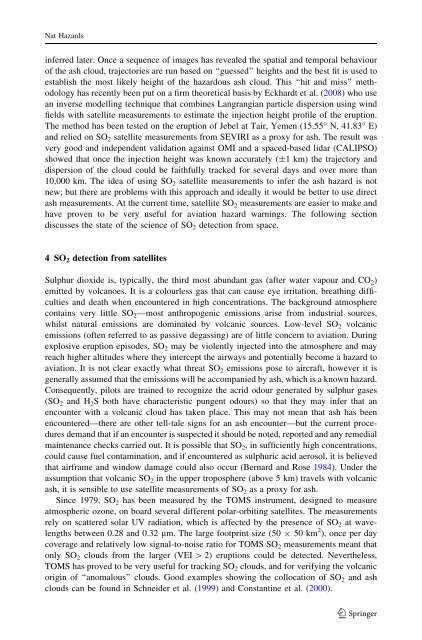Satellite detection of hazardous volcanic clouds and ... - Savaa - NILU
Satellite detection of hazardous volcanic clouds and ... - Savaa - NILU
Satellite detection of hazardous volcanic clouds and ... - Savaa - NILU
You also want an ePaper? Increase the reach of your titles
YUMPU automatically turns print PDFs into web optimized ePapers that Google loves.
Nat Hazardsinferred later. Once a sequence <strong>of</strong> images has revealed the spatial <strong>and</strong> temporal behaviour<strong>of</strong> the ash cloud, trajectories are run based on ‘‘guessed’’ heights <strong>and</strong> the best fit is used toestablish the most likely height <strong>of</strong> the <strong>hazardous</strong> ash cloud. This ‘‘hit <strong>and</strong> miss’’ methodologyhas recently been put on a firm theoretical basis by Eckhardt et al. (2008) who usean inverse modelling technique that combines Langrangian particle dispersion using windfields with satellite measurements to estimate the injection height pr<strong>of</strong>ile <strong>of</strong> the eruption.The method has been tested on the eruption <strong>of</strong> Jebel at Tair, Yemen (15.55° N, 41.83° E)<strong>and</strong> relied on SO 2 satellite measurements from SEVIRI as a proxy for ash. The result wasvery good <strong>and</strong> independent validation against OMI <strong>and</strong> a spaced-based lidar (CALIPSO)showed that once the injection height was known accurately (±1 km) the trajectory <strong>and</strong>dispersion <strong>of</strong> the cloud could be faithfully tracked for several days <strong>and</strong> over more than10,000 km. The idea <strong>of</strong> using SO 2 satellite measurements to infer the ash hazard is notnew; but there are problems with this approach <strong>and</strong> ideally it would be better to use directash measurements. At the current time, satellite SO 2 measurements are easier to make <strong>and</strong>have proven to be very useful for aviation hazard warnings. The following sectiondiscusses the state <strong>of</strong> the science <strong>of</strong> SO 2 <strong>detection</strong> from space.4 SO 2 <strong>detection</strong> from satellitesSulphur dioxide is, typically, the third most abundant gas (after water vapour <strong>and</strong> CO 2 )emitted by volcanoes. It is a colourless gas that can cause eye irritation, breathing difficulties<strong>and</strong> death when encountered in high concentrations. The background atmospherecontains very little SO 2 —most anthropogenic emissions arise from industrial sources,whilst natural emissions are dominated by <strong>volcanic</strong> sources. Low-level SO 2 <strong>volcanic</strong>emissions (<strong>of</strong>ten referred to as passive degassing) are <strong>of</strong> little concern to aviation. Duringexplosive eruption episodes, SO 2 may be violently injected into the atmosphere <strong>and</strong> mayreach higher altitudes where they intercept the airways <strong>and</strong> potentially become a hazard toaviation. It is not clear exactly what threat SO 2 emissions pose to aircraft, however it isgenerally assumed that the emissions will be accompanied by ash, which is a known hazard.Consequently, pilots are trained to recognize the acrid odour generated by sulphur gases(SO 2 <strong>and</strong> H 2 S both have characteristic pungent odours) so that they may infer that anencounter with a <strong>volcanic</strong> cloud has taken place. This may not mean that ash has beenencountered—there are other tell-tale signs for an ash encounter—but the current proceduresdem<strong>and</strong> that if an encounter is suspected it should be noted, reported <strong>and</strong> any remedialmaintenance checks carried out. It is possible that SO 2 , in sufficiently high concentrations,could cause fuel contamination, <strong>and</strong> if encountered as sulphuric acid aerosol, it is believedthat airframe <strong>and</strong> window damage could also occur (Bernard <strong>and</strong> Rose 1984). Under theassumption that <strong>volcanic</strong> SO 2 in the upper troposphere (above 5 km) travels with <strong>volcanic</strong>ash, it is sensible to use satellite measurements <strong>of</strong> SO 2 as a proxy for ash.Since 1979, SO 2 has been measured by the TOMS instrument, designed to measureatmospheric ozone, on board several different polar-orbiting satellites. The measurementsrely on scattered solar UV radiation, which is affected by the presence <strong>of</strong> SO 2 at wavelengthsbetween 0.28 <strong>and</strong> 0.32 lm. The large footprint size (50 9 50 km 2 ), once per daycoverage <strong>and</strong> relatively low signal-to-noise ratio for TOMS SO 2 measurements meant thatonly SO 2 <strong>clouds</strong> from the larger (VEI [ 2) eruptions could be detected. Nevertheless,TOMS has proved to be very useful for tracking SO 2 <strong>clouds</strong>, <strong>and</strong> for verifying the <strong>volcanic</strong>origin <strong>of</strong> ‘‘anomalous’’ <strong>clouds</strong>. Good examples showing the collocation <strong>of</strong> SO 2 <strong>and</strong> ash<strong>clouds</strong> can be found in Schneider et al. (1999) <strong>and</strong> Constantine et al. (2000).123
















